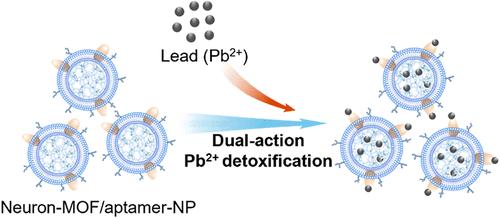Dual-Action Cellular Nanoparticles for Effective Lead (Pb2+) Detoxification
IF 16
1区 材料科学
Q1 CHEMISTRY, MULTIDISCIPLINARY
引用次数: 0
Abstract
Lead (Pb2+) exposure remains a persistent and serious public health concern due to its widespread presence and profound toxicity. Building on recent advances in toxin-neutralizing cell membrane-coated nanoparticles (CNPs) and the discovery of Pb2+-binding DNA aptamers, we develop dual-action neuron-mimetic CNPs for effective Pb2+ detoxification. In the formulation, the CNPs encapsulate aptamers within metal–organic framework (MOF) cores and coated with membranes derived from SH-SY5Y neuroblastoma cells, two functional components working together to neutralize Pb2+. The resulting constructs, termed Neuron-MOF/aptamer-NPs, exhibit strong Pb2+ binding capacity, excellent colloidal stability in physiological media, and resistance to DNA leakage. In vitro assays identify Neuron-MOF/aptamer-NPs as the most potent formulation, demonstrating dual-action neutralization against Pb2+-induced toxicity, oxidative stress, and lipid peroxidation in SH-SY5Y cells. In vivo, Neuron-MOF/aptamer-NP treatment significantly improves survival in a mouse model of lead poisoning and reduces hematologic, hepatic, and renal damage. Behavioral assessments further confirm the restoration of spatial memory and locomotor function. Neuron-MOF/aptamer-NPs exhibit no signs of acute toxicity in healthy mice. These findings establish Neuron-MOF/aptamer-NPs as a potent and biocompatible therapeutic platform for targeted lead detoxification with systemic and neuroprotective benefits.

双作用细胞纳米颗粒有效的铅(Pb2+)解毒
铅(Pb2+)暴露由于其广泛存在和严重的毒性,仍然是一个持续和严重的公共卫生问题。基于毒素中和细胞膜包被纳米颗粒(CNPs)的最新进展和Pb2+结合DNA适体的发现,我们开发了双作用神经元模拟CNPs,用于有效的Pb2+解毒。在配方中,CNPs将适体包裹在金属有机框架(MOF)核心内,并涂覆来自SH-SY5Y神经母细胞瘤细胞的膜,两种功能成分共同作用以中和Pb2+。由此构建的神经元- mof /适配体- nps具有很强的Pb2+结合能力,在生理介质中具有优异的胶体稳定性,并具有抗DNA泄漏的能力。体外实验发现神经元- mof /适配体- nps是最有效的配方,在SH-SY5Y细胞中显示出对Pb2+诱导的毒性、氧化应激和脂质过氧化的双重作用中和。在体内,神经元- mof /适配体- np治疗可显著提高铅中毒小鼠模型的存活率,减少血液学、肝脏和肾脏损害。行为评估进一步证实了空间记忆和运动功能的恢复。在健康小鼠中,神经元- mof /适配体- nps未表现出急性毒性迹象。这些发现确立了神经元- mof /适配体- nps作为靶向铅解毒的有效和生物相容性治疗平台,具有全身和神经保护作用。
本文章由计算机程序翻译,如有差异,请以英文原文为准。
求助全文
约1分钟内获得全文
求助全文
来源期刊

ACS Nano
工程技术-材料科学:综合
CiteScore
26.00
自引率
4.10%
发文量
1627
审稿时长
1.7 months
期刊介绍:
ACS Nano, published monthly, serves as an international forum for comprehensive articles on nanoscience and nanotechnology research at the intersections of chemistry, biology, materials science, physics, and engineering. The journal fosters communication among scientists in these communities, facilitating collaboration, new research opportunities, and advancements through discoveries. ACS Nano covers synthesis, assembly, characterization, theory, and simulation of nanostructures, nanobiotechnology, nanofabrication, methods and tools for nanoscience and nanotechnology, and self- and directed-assembly. Alongside original research articles, it offers thorough reviews, perspectives on cutting-edge research, and discussions envisioning the future of nanoscience and nanotechnology.
 求助内容:
求助内容: 应助结果提醒方式:
应助结果提醒方式:


